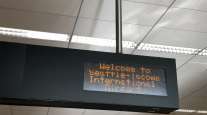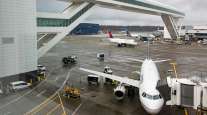Seattle Port Finds a Partner for Major Upgrade to Terminal

The Port of Seattle is one step closer to playing — or, at the very least, staying — in the big leagues of the global freight business.
On Feb. 5, officials with the Northwest Seaport Alliance, the joint venture between the ports of Seattle and Tacoma, unveiled a tentative deal with Seattle-based Stevedoring Services of America Terminals, one of the world’s largest terminal operators, to manage a planned “big ship” loading facility on Terminal 5, just west of Harbor Island.
The long-sought deal would be a major step in a proposed $500 million-plus upgrade to Terminal 5 that will allow the Puget Sound cargo gateway to handle more of the super-large freighters that are reshaping global trade.
Capable of handling 18,000 or more 20-foot containers, or nearly twice as much as many of the vessels currently visiting West Coast ports, these massive ships have brought huge cost savings to the freight business and have helped drive down consumers’ costs of everything from toys to grain to consumer electronics. But that scale also helped turn the global shipping business into a brutal competition among North American ports.
The rivalry is especially intense between Seattle-Tacoma and two Canadian ports — Vancouver and Prince Rupert, whose aggressive expansions have cut deeply into the alliance’s business.

A ship docked at a grain terminal in the Port of Seattle. (Ted S. Warren/Associated Press)
“We’re seeing modest growth [in container volumes], but we’re losing market share,” alliance CEO John Wolfe said during a briefing to port commissioners Feb. 5. “We need to find a way to turn that trend.”
With a final vote scheduled for Feb. 26, Wolfe and other alliance officials will spend the next three weeks trying to build public and political support for the massive project, the first phase of which could get underway as early as this summer.
It’s an ambitious schedule, given the project’s complexity, large public costs and substantial risk. While Stevedoring Services and its partner, Terminal International Ltd., could pay up to $250 million of the projected costs, the ports of Seattle and Tacoma will be on the hook for $340 million.
In theory, the ports will earn back their investment by 2037 via lease payments from the terminal operators. But that best-case scenario could falter if the alliance’s anticipated cargo volumes fail to materialize or if the terminal operators elect not to participate in the project’s second phase.
“There is no guarantee in anything, but we’re taking a calculated gamble,” Edward DeNike, president of SSA Containers, told commissioners during the Feb. 5 briefing.
Given how rapidly the global cargo market is changing, the real risk for the Terminal 5 upgrade isn’t that the best case fails to materialize, but that even under the best case, the ports may struggle to meet their goals.

Port of Seattle (Ted S. Warren/Associated Press)
The shift to larger, more cost-effective containerships has upended the entire shipping sector. The larger vessels require larger, more expensive facilities — deeper harbors, bigger and more powerful cranes, stronger piers and improved capacity to move the containers to and from truck chassis and railcars. These realities have pushed ports into a costly arms race of infrastructure investments.
But the larger vessels have had another, even harsher effect. Shippers need fewer vessels “and fewer vessels means fewer ports of call,” said Seattle Port Commission President Stephanie Bowman, co-chair of the seaport alliance, in an interview before the Feb. 5 briefing. “So the competition [among ports] has absolutely ramped up.”
Between 2012 and 2017, the alliance’s share of container cargo flowing into the Pacific Northwest fell from 43.7% to 39.5%, while the shares flowing into Vancouver and Prince Rupert have soared, according to cargo-data firm PIERS.
One factor behind that shift is infrastructure. Vancouver and Prince Rupert have poured hundreds of millions of dollars into new facilities, much of it geared toward ultra-large vessels. Both ports have plans for additional spending, according to Wolfe.
But another factor is the higher cost of shipping through all U.S. West Coast ports.
Thanks in part to Canadian government subsidies, rail costs between the Canadian West Coast and the U.S. Midwest are far lower than the same trip from U.S. West Coast ports such as Seattle-Tacoma or Los Angeles-Long Beach.
U.S. ports also impose a special Harbor Maintenance Tax, stemming from federal clean-water regulation, which adds as much as $150 to the cost of shipping a container, according to the alliance.

Ted S. Warren/Associated Press
The Seattle and Tacoma ports also are hobbled by higher labor costs, according to SSA’s DeNike.
All told, shippers can save around $400 per container by offloading at Canadian ports compared with U.S. West Coast ports, according to a 2018 study by the alliance.
Another threat: With the widening of the Panama Canal in 2016, shippers find it increasingly cost-effective to bring their cargoes in to the United States via East Coast and Gulf Coast ports. That shift comes at the expense of Seattle-Tacoma and other West Coast ports.
Between January and September 2018, West Coast container imports increased just 3.3%, while East Coast ports saw a 6.3% jump and ports on the Gulf Coast saw a 10.6% increase, according to data from PIERS.
What’s more, even the most ardent boosters at the alliance acknowledge that, in the short-term, the upgrade is really about stemming the defection of shippers to other ports. “This investment is more about ‘build it so they will stay’ rather than ‘build it and they will come,’” Don Esterbrook, the alliance’s deputy CEO, told the commissioners.
But commissioners say they are fighting for more than just a top spot in the hierarchy of American ports. The port represents one of the few regional industries still generating middle-class wages: The two ports directly contribute to 20,100 jobs with an average salary of $95,000, according to Port of Seattle figures. Every new increment of container traffic the port wins — or doesn’t lose — represents the kind of “jobs that allow you to live and work in Seattle,” Bowman said.
Wolfe said, “There are no guarantees, but there are risks, certainly, with sitting tight with the infrastructure that we have.”
Distributed by Tribune Content Agency, LLC



